Diversity and Equity
Build a Better Book
The Value of Adding Meaning to the Making
Connected Science Learning July–September 2020 (Volume 2, Issue 3)
By Stacey Forsyth, Kathryn Penzkover, Bridget Dalton, and Gigi Yang
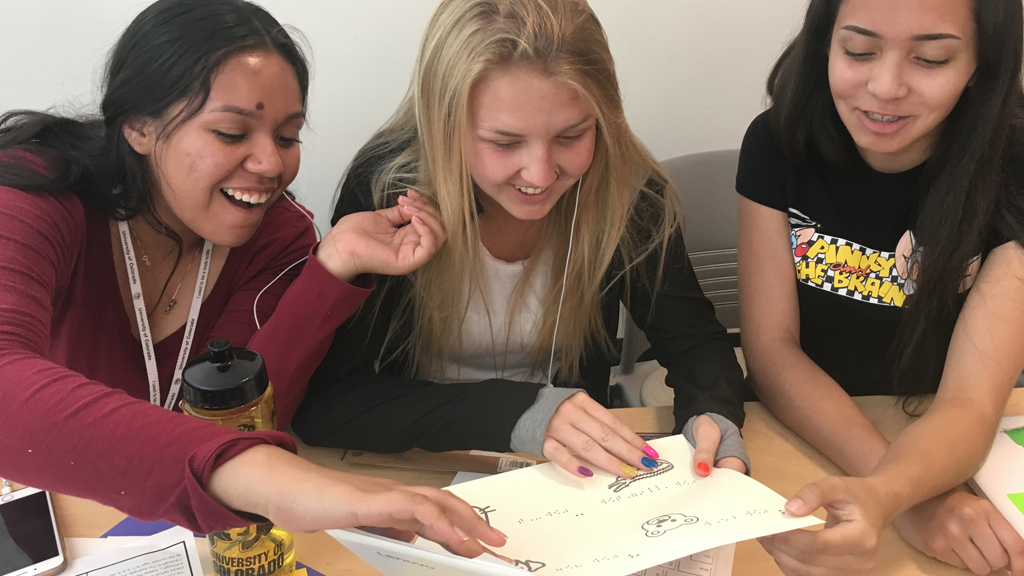
“Empathy makes you a better innovator. If I look at the most successful products we [at Microsoft] have created, it comes with the ability to meet the unmet, unarticulated needs of customers.” —Satya Nadella, Microsoft CEO.
It is summer in Colorado and a group of motivated middle school students from the Denver area is putting the finishing touches on a collection of very special board games. Over the past five days, the group has used a variety of maker technologies to design and fabricate more accessible versions of some classic board games, including Clue, Chutes and Ladders, and Othello (Figure 1). They have created 3-D–printed game pieces that are discernable by both color and touch, and used a laser cutter to make tactile game boards. Some have added sound cues triggered by QR codes or copper tape connected to a Makey Makey; others have used Scratch to program audio dice. Most have added different textures or braille labels to their game board to help orient new players. All have spent a week highly engaged in a maker experience focused on the creation of board games designed for those who cannot see. This summer program is just one example of similar efforts taking place in school and library makerspaces across the United States. From summer camps and afterschool programs, to maker units integrated in science, art, language arts, English language learner (ELL), and computer science classrooms, youth around the country engaged in the Build a Better Book project are developing design thinking skills as they work to create more accessible books and learning materials for youth who are blind or have low vision (BLV).
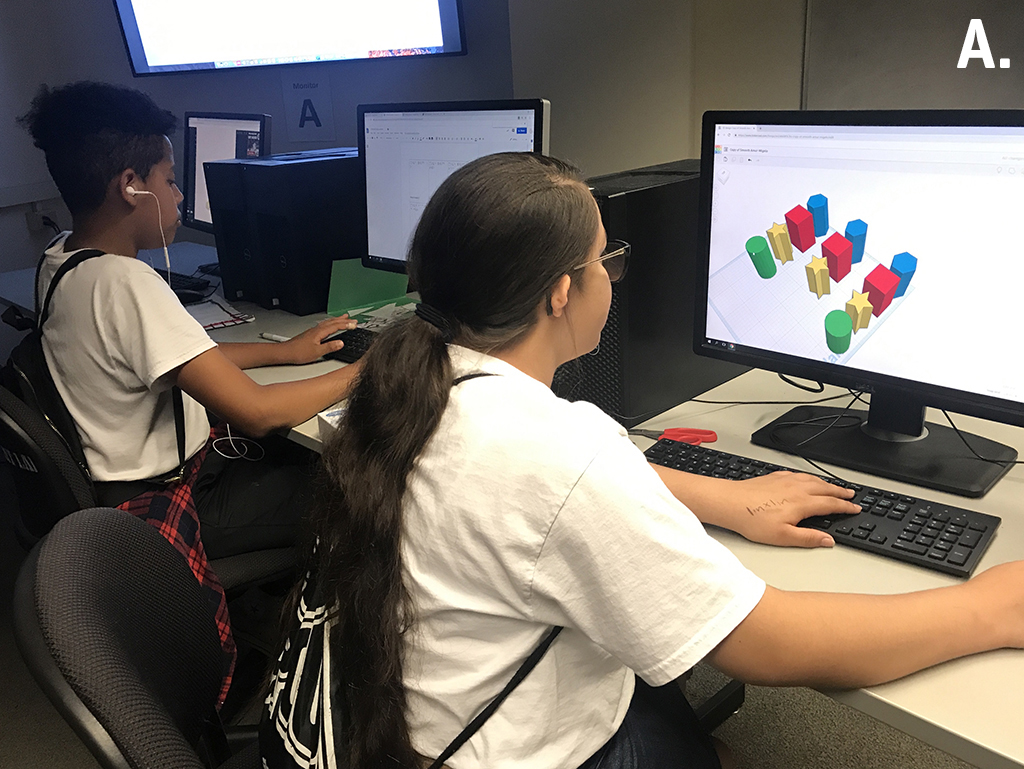
Build a Better Book project overview
The Build a Better Book project (BBB), based at the University of Colorado Boulder, is a unique makerspace initiative that engages youth in an authentic, empathy-driven design experience in which they create inclusive, multimodal learning materials for children who are BLV. Despite significant advances in technology, the library of accessible materials available for youth with visual impairments remains extremely limited, leading to sharp disparities in access to information. In collaboration with sculptor and tactile artist Ann Cunningham, art educator at the Colorado Center for the Blind, we developed a program that empowers youth to use a variety of maker technologies to help address this need. Participants engage in empathy-building and immersive tactile activities, and have conversations with peers and community mentors who are BLV, to better understand the unique needs of their end users. They gain experience with a variety of maker tools—from cardboard and craft materials to 3-D printers, laser cutters, and Makey Makeys—as they create products with tactile and audio features. Throughout the design and fabrication process, participants evaluate existing products to identify assets and limitations, select materials and tools that will enable them to effectively communicate information in different modes, and iteratively build and improve their designs using feedback from others, including users with visual impairments. The opportunity to support people with disabilities provides a strong motivation for many youth to participate, and increases participants’ confidence in their belief that they can use technology for social good.
We initially developed Build a Better Book for implementation in public libraries, in response to the rapid expansion of makerspaces at these community sites. Many librarians, finding themselves newly appointed as makerspace managers, were seeking not only support in facilitating maker activities at their sites, but also a real-world purpose for their making projects. Public libraries have long played a critical role in democratizing access to information, and the project seemed a good fit for libraries looking to strengthen the connection between literacy and maker programming. Despite the strong alignment in mission, however, public libraries presented a key challenge for the program, namely that youth attendance can be unpredictable in informal settings, particularly for multiweek projects. To address this, we initially developed BBB as a series of short afterschool or weekend workshops, each focused on a particular technology. The complex nature of the design task, however, combined with the time required to immerse participants in empathy-building activities, required a greater time investment. As a result, we began testing more extended program formats, including summer camps and a design internship model held at a library makerspace. We immediately saw the benefits of these longer programs and it was not long before we received substantial interest from in-school educators as well.
Over the past three years, Build a Better Book has evolved from a local, library-based program to a national network of more than 85 educators implementing the program across informal and formal learning settings in 18 states, plus Washington, DC. Collaboration among educators and across learning environments has vastly improved the program and demonstrated the wide variety of ways it can be adapted for different contexts. Now in its fourth year, the BBB network spans the United States, with participants ranging from early elementary students through high school teens working in diverse settings such as summer camps, afterschool programs, and science, engineering, literacy, art, and ELL classrooms.
Like other makerspace initiatives, Build a Better Book offers youth an opportunity to engage in critical STEM (science, technology, engineering, and math) practices, such as design, fabrication, iteration, and collaboration. There is compelling evidence that making activities have the potential to engage students in creative problem-solving, support students in developing confidence and persistence, build positive STEM identities, and broaden participation in STEM fields (Vossoughi and Bevan 2014). Build a Better Book also provides youth a unique opportunity to learn about accessibility and universal design while creating a product for others. The process requires that they learn about the specific needs of their end users and take the perspective of others throughout the design process. Participants develop not only technological skills but also, and perhaps more importantly, a deeper understanding of how to design for diverse users.
Guiding principles
When we first began to expand the program, librarians and educators frequently had one question for us: What technology do we need? The answer to this is simple: There is no one required technology; the program is flexible and adaptable, and can be integrated into both low- and high-tech learning environments. Over the past three years, however, we have identified five guiding principles that enhance the BBB learning experience across different contexts.
Focus on empathy
We center empathy at the heart of design thinking, as enhanced understanding of the end user serves to improve a product’s design. In BBB, participants engage in a series of empathy-building activities to personally experience tactile sense-making and better understand critical design considerations. When possible, peers and community mentors who are BLV participate in workshops as codesigners, providing input and feedback throughout the design process.
Asset-based approach
BBB takes an asset-based approach to learning about end users, with a focus on individuals’ abilities rather than their limitations. For many participants, this leads to an important shift from initially viewing individuals who are BLV as dependent on others for help, to appreciating them as agentive, accomplished individuals who also benefit from accessible materials and assistive technologies. Sharing video resources featuring BLV individuals and inviting BLV members of the community to work alongside students as codesigners reinforces an asset-based view and focuses the work on the end user’s unique needs.
Universal design for learning
Universal design for learning (UDL) values learning differences and aims to help all students achieve by reducing barriers to learning (Meyer, Rose, and Gordon 2014). UDL design principles focus on representing information in multiple formats and offering learners multiple means of engagement, action, and expression (CAST 2018). In BBB, participants evaluate the design of existing products (such as books or games) and weigh the affordances of different materials and technologies as they learn to design for a range of diverse needs and interests. Following this process, youth often recognize that designing a product for someone with a disability frequently improves the product for all.
Iterative design
Developing and testing prototypes, creative problem-solving, and experiencing failure are all central to the making process. In BBB, we find that it is worthwhile to invest the time in soliciting and responding to user feedback from BLV and sighted individuals. This is a critical, impactful step that helps participants work through failure and understand the value of feedback in improving product design. BBB partners have collaborated with special education departments, blind-serving organizations in their community, and other network members to test and improve BBB designs.
Opportunity to share and celebrate the work
As a final stage in the process, we encourage BBB programs to conclude with a culminating event or display that serves to share participants’ work with the broader community. Sample events have included opportunities for youth designers to test their products with younger students at a local school, display projects at libraries or museums (Figure 2), show their prototypes to family members as part of an interactive showcase, and share projects at community festivals and exhibits. Designers can also share their work in online spaces such as the BBB Design Gallery.
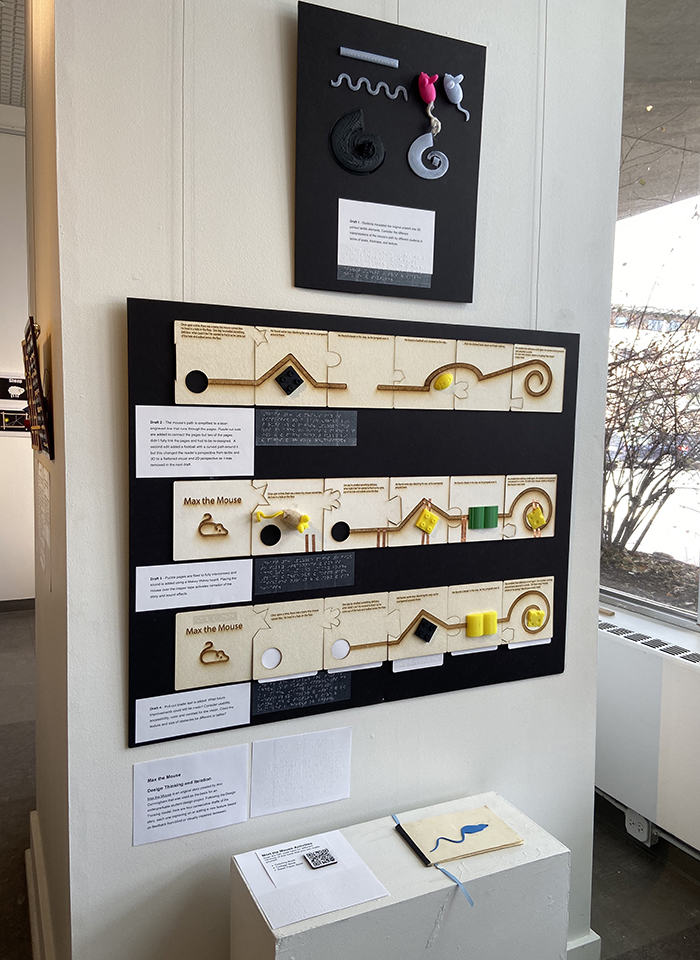
The Boulder Public Library’s Stories for Your Senses exhibit featured youth-designed products and highlighted the iterative design process. In addition to written descriptions, exhibit signage included information presented in braille and audio captions accessed through QR codes.
Building the foundation
Regardless of the learning environment, all BBB programs begin with a series of empathy-building activities to introduce participants to the design thinking process and prompt them to think about someone else’s experience and perspective. We introduce participants to design thinking as an iterative, nonlinear process grounded in empathy (as presented by the Stanford d.school) and containing the following steps:
- Empathize to better understand the end user.
- Define the problem.
- Ideate to generate ideas for potential solutions.
- Prototype to explore and test a possible solution.
- Test to get feedback from users and refine solutions.
Many workshops begin with an interactive team exercise, in which groups brainstorm ideas for a new product designed for a specific imaginary client. Each team reviews an illustrated card to learn about the client and considers the client’s specific needs when brainstorming product ideas (Figure 3). We have found this activity effectively engages participants across a wide range of ages, sparking new ideas and stimulating them to align product features to specific user needs.
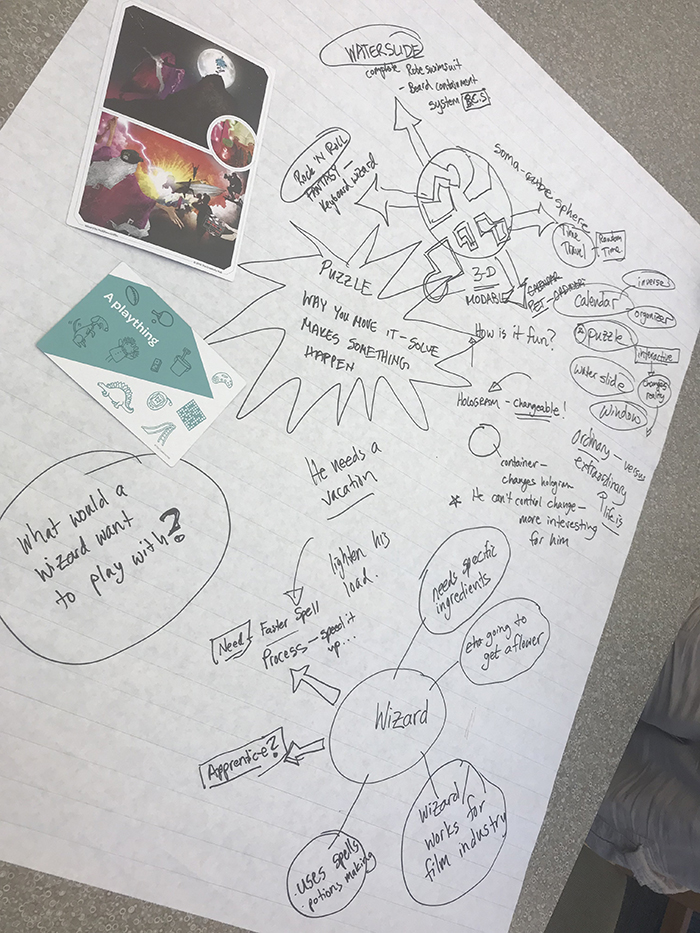
What type of toy would a wizard enjoy?
Ideas brainstormed for a wizard’s toy include a water slide and a hologram puzzle.
Following this introduction to design thinking, BBB programs introduce participants to their end users—in most cases, individuals who are BLV. This can involve meeting with peers or community mentors who are visually impaired, viewing videos that share the accomplishments of individuals who are blind, or hands-on exercises performed while wearing glasses that simulate different vision impairments. Together, these activities help broaden participants’ awareness of disability, particularly blindness, and increase their understanding that different end users may have different abilities and preferences.
As a final step before launching into product design, youth engage in tactile activities to identify key design considerations for effective tactile graphics. This may involve sculpting objects out of clay, exploring different textured materials, or using wax sticks (e.g., Wikki Stix) to create tactile images. Many groups opt to play a game in which a designer creates a tactile image to be interpreted by other team members who are blindfolded. Through this exercise, youth designers intuit key design principles, such as emphasizing the most critical elements of an illustration, minimizing unnecessary detail, and providing context and labels (Figure 4).
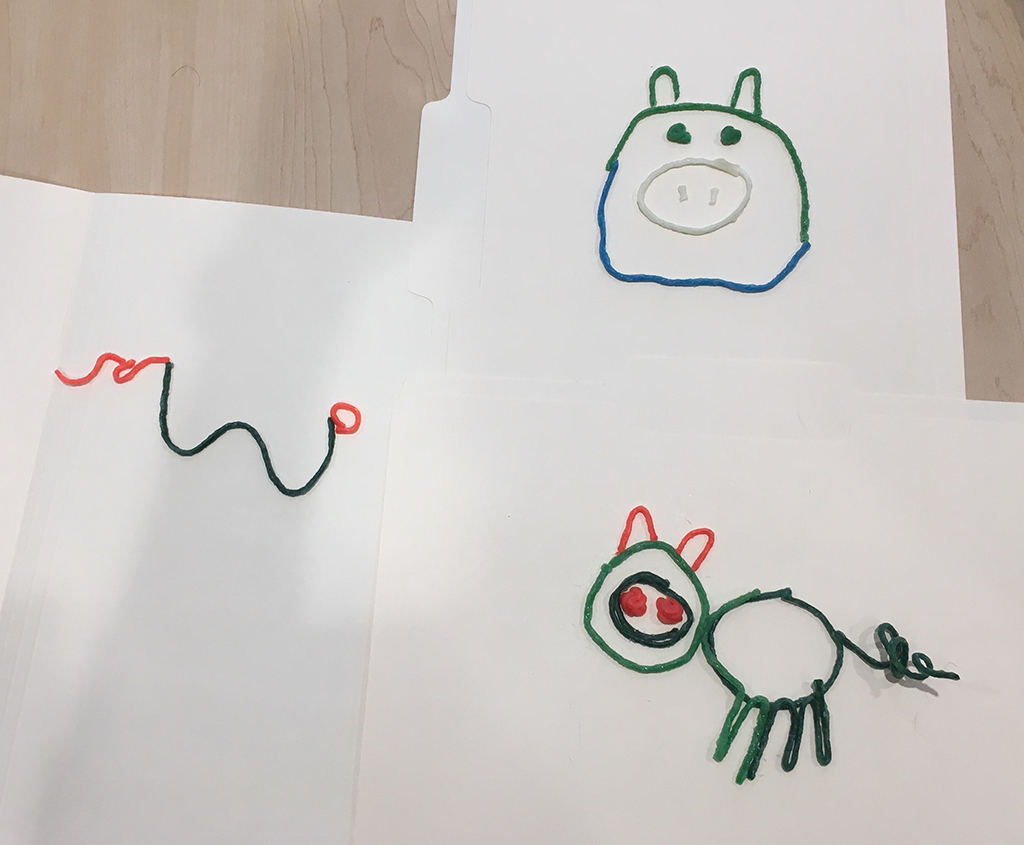
Three tactile representations of a pig, created by educators during a professional development workshop. The image on the left was created by an educator who is blind; the images on the right were created by individuals who are sighted. The examples highlight several distinguishing features, including a pig’s snout, ears and curly tail.
Build a Better Book implementation in formal and informal settings
Across the United States, a growing network of librarians and educators is implementing BBB in different ways, in both formal and informal learning environments. Numerous summer camps and design internships have engaged middle and high school youth during out-of-school-time (Figures 5 and 6). In Colorado, teens involved in a week-long summer program at a library makerspace immersed themselves in the ecology of a nearby creek, and then used different maker technologies to communicate their experience through multimodal books, models, and games. In Baltimore, Maryland, the State Library for the Blind and Physically Handicapped (LBPH) teamed up with several community partners to lead a multiweek summer program for teens, who designed multimodal products based on children’s songs and fairy tales. To conclude the program, teens visited LBPH to share and test their products with library patrons and staff who are visually impaired.
In the classroom, teachers have effectively integrated BBB as a problem-based learning (PBL) unit across a range of disciplines and ages, from a first-grade literacy unit to a high school design project, in which ELL students developed bilingual, tactile picture books. In California, a team of seventh-grade science teachers collaborated to incorporate a multimodal design project into their unit on sensory reception. After conducting research about the senses, students worked in teams to share their findings in hand-crafted, multimodal books that incorporated tactile, light, and audio features.
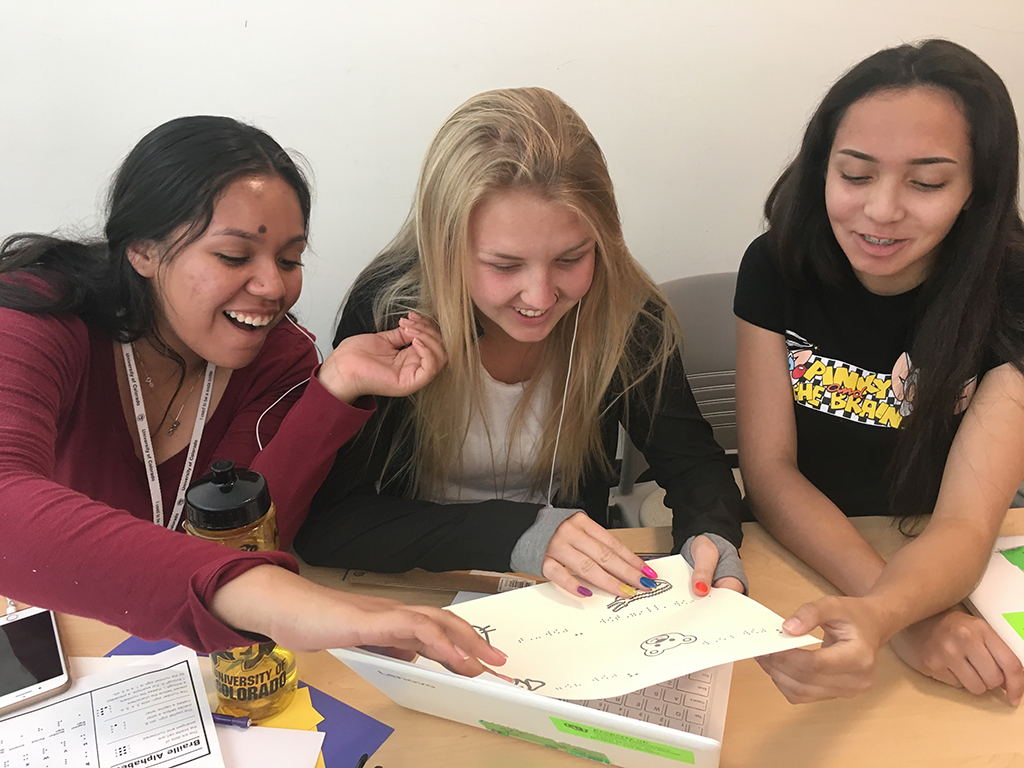
Precollegiate students in a university summer program react to the tactile version of their alphabet book, designed in Adobe Illustrator and created with swell paper run through a PIAF (Picture-in-a-Flash) machine.
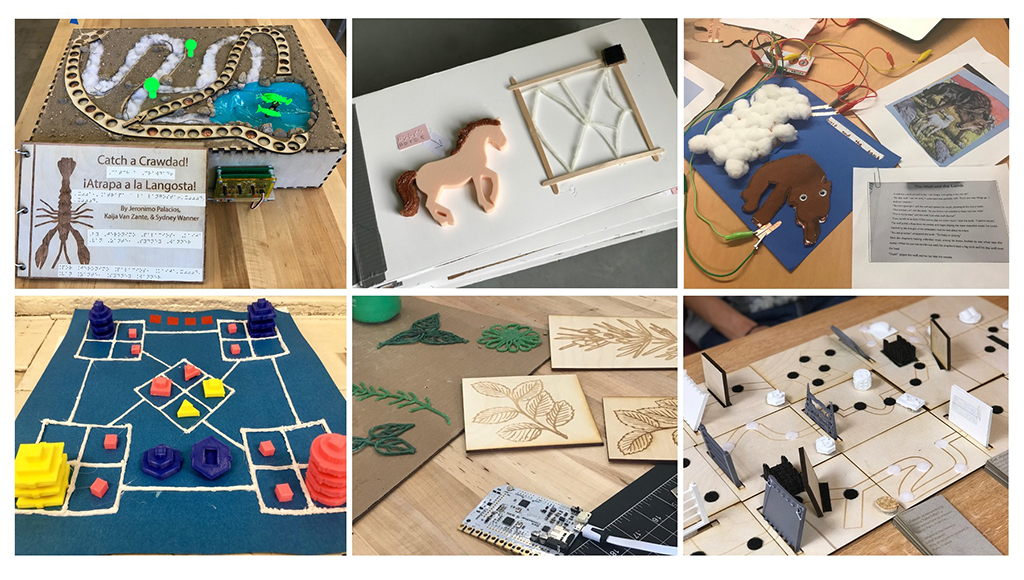
Multimodal products, including stories, books, games, and museum exhibit pieces, created during Build a Better Book programs.
Some partners have implemented more extensive versions of the program. In Alabama, for example, a middle school librarian and school district technologist teamed up to run a year-long makerspace elective focused on integrating art and technology to help others. Participants gained experience with technology as they designed tactile coloring pages for children with visual impairments and created a tactile alphabet book to teach children how to use a Perkins Brailler (Figure 7a). Students then used their UDL and maker skills to fabricate standards-aligned kits that incorporated tactile and auditory features to teach sixth-grade science and social studies concepts to youth who are BLV. This project enabled participants to support their peers by designing more accessible learning materials. The kits are now maintained by the school library, available for teachers to check out and share with their classes. After observing high student engagement in the program, the team also facilitated a “Build a Better Game” elective for elementary students, in which participants evaluated and redesigned popular children’s board games to be more accessible (Figure 7b). The goals of the program were for participants to not only gain experience with design thinking and create products that will support students who are visually impaired, but also to better understand that not everyone learns in the same way. Their project has sparked new partnerships with community organizations, including the Birmingham Zoo, a school field trip destination that is now collaborating with the team to develop tactile learning materials for visitors with visual impairments.
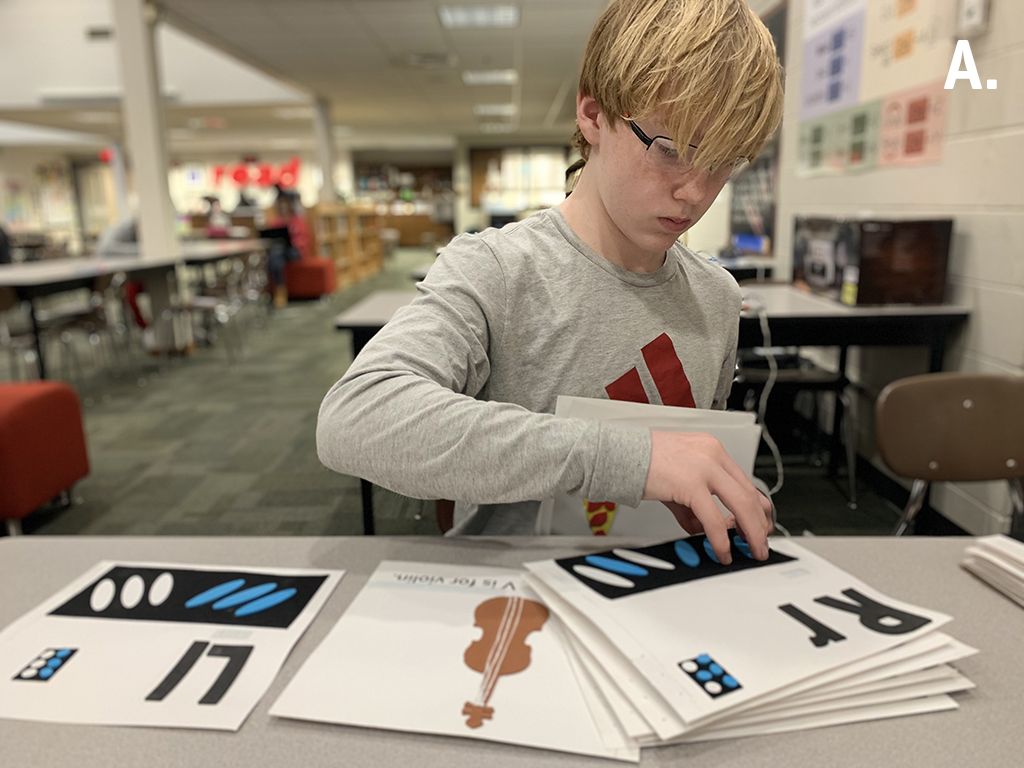
(A) A middle school student preps pages for binding into a new tactile alphabet book designed to teach young students with visual impairments how to use a Perkins Brailler. (B) Elementary students brainstorm ways to make a board game more accessible.
Some of the most innovative adaptations of BBB have occurred at the intersection of formal and informal learning environments. In New Jersey, for example, a public library makerspace manager teamed up with a high school computer science teacher to design more accessible digital tools. Teams made 3-D–printed models and puzzles to demonstrate math concepts, used a laser cutter to create tactile board games, and designed physical tablet overlays that enable users, regardless of sight, to interact with tablet apps and games. After testing prototypes at a school for the blind, students improved their products and decided to learn new programming languages, such as Swift and XCode, to design more accessible apps. According to the makerspace manager, “There have been a ton of positive learning experiences from this overall. Most importantly, it is a great illustration for the computer science students to learn that developing with accessibility in mind is not only a good thing to do, but the correct way to program.”
Research and evaluation findings
Over the project’s first three years, we found evidence that empathy is a strong hook for both educators and youth. Librarians and teachers working in a variety of settings are drawn to the program because of its focus on empathy and designing for others. Similarly, youth opting to participate in informal BBB programs cite their interest in helping others as a primary motivation. In applications required for four informal BBB programs, for example, 72% of girls and 57% of boys cited “helping others” as their primary motivation to participate, as compared to 17% of girls and 25% of boys who cited an interest in technology as their primary motivation (n = 57 applicants, 28 boys and 29 girls). We have observed strong participation by girls, who engage in informal BBB programs at higher rates than in comparable non-BBB maker programs. In the program’s first two years (2017–18), girls comprised 61% of middle school BBB participants, relative to 35% in comparable non-BBB maker programs, and 36% of high school BBB participants, relative to 17% in comparable non-BBB maker programs.
Across different contexts, research and evaluation findings suggest that Build a Better Book holds promise for engaging youth in STEM and motivating them to persist through challenging obstacles. In 2019, observations of five BBB programs and interviews with 11 expansion site facilitators documented very high student engagement throughout the program, with several facilitators reporting that BBB attracted a wider diversity of students and that those students were more invested and engaged in their BBB designs than in other comparable makerspace projects (Thiry 2019). One librarian facilitating an afterschool program commented, “The kids were so engaged. We had zero behavior challenges. It was just one of those experiences where they were all-in; even when their parents came to pick them up, they were still working,” (Thiry 2019). Another librarian expressed, “I had a lot of other kids who came who had never [come to the makerspace] before. It definitely drew a different crowd and they took it much more seriously. They had a lot more really thoughtful discussions about what they were doing than we’d really had in other big projects that we’ve done in the makerspace” (Thiry 2019).
Participants appreciate the authentic nature of the design task, feel like they are creating something that may improve someone’s life, and value the feedback they receive during design sessions with community mentors who are visually impaired. Providing students with the freedom to select from multiple modes and tools led to the development of positive STEM leadership identities, with some designers developing technology skills and taking on a “tech expert” role among their peers (Walsh 2017). Multiple librarians reflected that the human-centered design task affected youths’ motivation and persistence. One stated, “The students in the program were really, really thoughtful about their product, about their prototype, and the decisions they were making. I think the students were very invested in completing their prototype, but not so much for themselves. They really wanted it done well. I think there’s been follow-through, not because they want a complete project for themselves, but because they really would like to see a student who is visually impaired interact with the prototype or the product” (Thiry 2019). Another librarian commented, “I really did feel like the kids put extra care into what they were doing because they knew that it wasn’t just something they were making that was going to sit in their school. It was literally going to somebody else. And it was made with more love and care I think because of the authenticity of it” (Thiry 2019).
Consistently, across different contexts, the most impactful part of BBB is its focus on inclusive design. Many participants reflect that the project has increased their awareness of the importance of designing books that are accessible for all children, including those with visual impairments (Dalton and Musetti 2018). Students feel they have a better understanding of disability and the importance of viewing the world from the perspective of someone with a disability (Thiry 2018). As one high school participant commented, “For me, I had never really thought about people with disabilities before or what they might need. Doing this project made me think more about the kinds of things people with disabilities might need—or the kinds of things they might need in the future.” In interviews, 95% of youth designers described gains in understanding universal design and in their ability to produce more accessible products for people with visual impairments or other disabilities.
The BBB intervention has proved to be highly adaptable for different disciplines, ages, and learning environments. Because the model does not require any specific technology or equipment, we have seen a variety of effective adaptations across different sites, ranging from low-tech classrooms to fully equipped makerspaces. In both informal and formal learning settings, the most effective programs enable youth to work on a multimodal project over the course of multiple sessions, with opportunities to test and iterate on their designs. Even more impactful are opportunities for youth designers to interact with peers or adults who are BLV and receive feedback from them (Figure 8). These interactions enable youth to improve their designs while increasing their awareness of others, particularly those living with a disability.
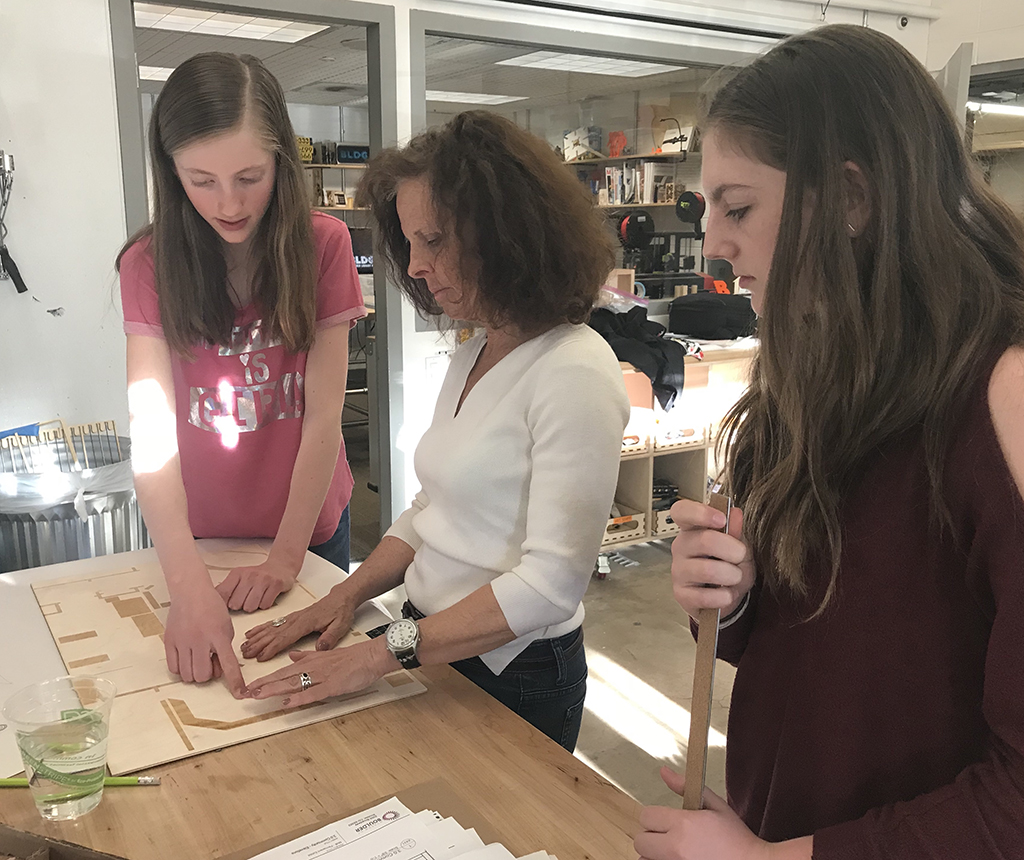
Community mentors who are blind or visually impaired test youth-designed products, including a laser-engraved museum map, and provide feedback to youth designers.
Potential challenges
Across all settings, educators describe BBB designers feeling most accomplished and satisfied when they have had a chance to test, iterate, and improve their designs. However, designing accessible materials is not easy, and providing sufficient time to lay the necessary foundation, learn the required technology skills, develop a design, fabricate a product, and then test and iterate on the design can be very challenging, particularly in informal settings such as libraries, which often run drop-in programs. Several partner sites tested new formats, such as offering multisession workshops, designing stand-alone sessions that can build on each other if youth attend multiple sessions, and delivering the program as a summer camp. Several informal sites also found it useful to implement a registration process to help track participation.
In formal settings, time is a constant challenge, particularly finding sufficient time to lay the foundation for the project and allow participants to explore and safely gain experience with available tools and technologies. Educators who integrated BBB as a content unit reflected that although this caused the unit to take more time (not surprisingly), students completed the unit with a deeper level of content knowledge. Some formal educators also voice concern about their lack of funding for maker equipment. However, numerous educators have led successful BBB programs by using low-cost materials, such as cardboard, craft materials, and recyclables, and by substituting lower-cost alternatives for certain maker tools, such as using craft cutters in place of laser cutters and 3-D printing pens in place of 3-D printers.
Facilitators interviewed across a range of formal and informal learning settings contributed the following advice for those interested in bringing BBB to their organization:
- Develop partnerships: Facilitators overwhelmingly reported that community partnerships—including agencies supporting those with disabilities, special education offices, and schools for the blind—were essential to the success of their program. Partnerships enabled facilitators to incorporate more effectively the perspective of the visually impaired community and make the experience “more real” for participating youth.
- Provide sufficient time across consecutive days or weeks for youth to design, test, and iterate on their product design: The design thinking process takes time, and facilitators noted that programs should allow time for exploration, creativity, and failure.
- Encourage student agency and creativity by offering a range of product choices and technologies, rather than a single assignment: Youth feel more invested in a product they have elected to work on, and making a variety of technologies available requires that they evaluate the relative affordances of different technologies to meet different goals.
- Allow time for discussion and exploration of universal design concepts and ideas: This is a new concept for most participants and it takes time and experience for them to understand its importance.
Conclusion
Several months after the middle school “Build a Better Game” camp, a 12-year-old girl and her mother sit across from each other at a table, engaged in a cut-throat game of Othello (Figure 9). It could be a scene from any family game night, but this is taking place at the National Federation of the Blind state convention in Colorado and the girl is visually impaired. She delights as she gradually takes over the game board, identifying her game pieces by touch and flipping them over in a tactile game grid created by a laser cutter. The game, originally designed and prototyped by a small team of middle school students, has been improved over multiple iterations through testing with users who are BLV: game pieces have been smoothed and 3-D–printed with two colors of filament, a raised dot has been added to the center of the board to orient players to the starting point, and the game board has been painted in high-contrast red and white as a visual cue for those with low vision. A family, previously hindered by traditional games, now has a game that they can play together, and a group of young designers is empowered and inspired, knowing that they can use their skills and technology to make the world a better place.
Stacey Forsyth (Stacey.Forsyth@colorado.edu) is director at CU Science Discovery at the University of Colorado Boulder.
Kathryn Penzkover is assistant director at CU Science Discovery at the University of Colorado Boulder.
Bridget Dalton is associate professor in the School of Education at the University of Colorado Boulder.
Gigi Yang is Build a Better Book program coordinator at the University of Colorado Boulder.
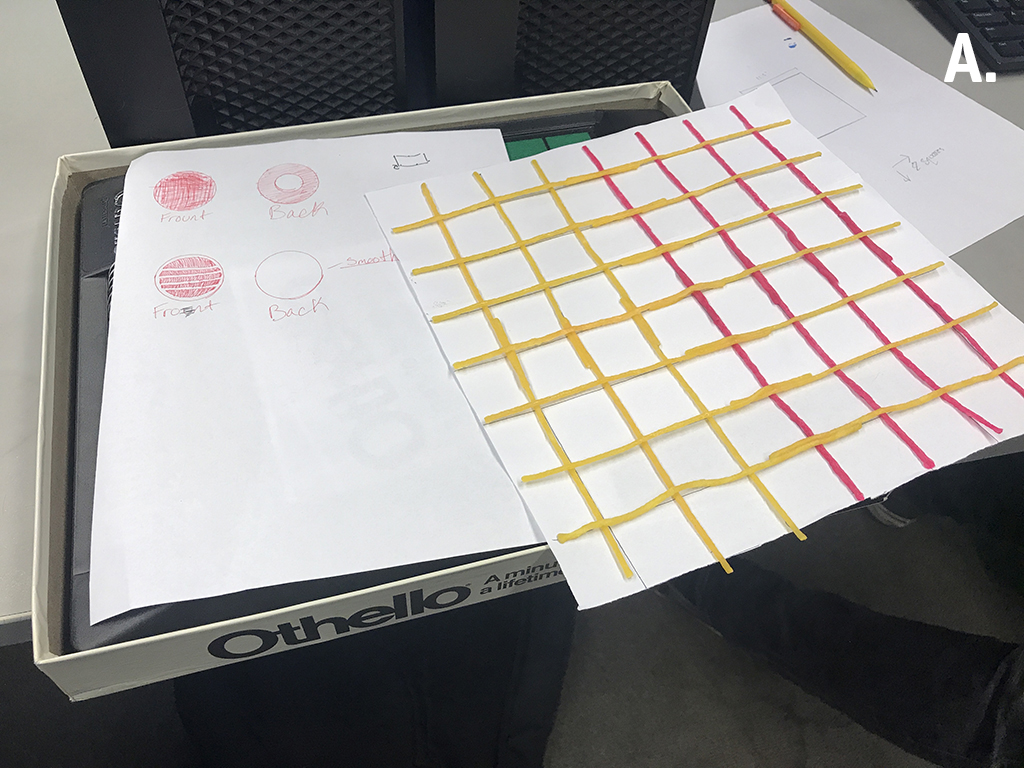
(A) Early prototype of a tactile Othello board game designed by middle school students, including sketches of tactile game pieces and a tactile game board created with paper and Wikki Stix. (B) Two teen girls with low vision play a later version of the game that incorporates 3-D–printed game pieces and a laser-cut game board.
Interested in bringing Build a Better Book to your community?
The Build a Better Book national network is available to help you bring this experience to your community. Visit the project website to dive into an array of online resources, explore project ideas contributed by other educators in our network, and find digital files to replicate youth-designed accessible products. We host an active listserv and several social media channels (including Twitter and Instagram) that enable BBB partners to share their work and troubleshoot potential hurdles. We also recommend that makerspaces, librarians, and STEM educators connect with others in their community. Needs abound, so try to identify partners in your community who might benefit from the making activities your youth are engaged in.
Acknowledgments
The Build a Better Book team gratefully acknowledges the valuable contributions of our partners at the Colorado Center for the Blind and our many library and school makerspace partners around the country, whose input and creativity have served to improve the program. This material is based upon work supported by the National Science Foundation under grants 1615247 and 1453771, and by the University of Colorado Boulder Office of Outreach and Engagement.
Middle School Elementary High School Informal Education Grade 1 Grade 2 Grade 3 Grade 4 Grade 5 Grades 6-8 Grades 9-12 Grade K


